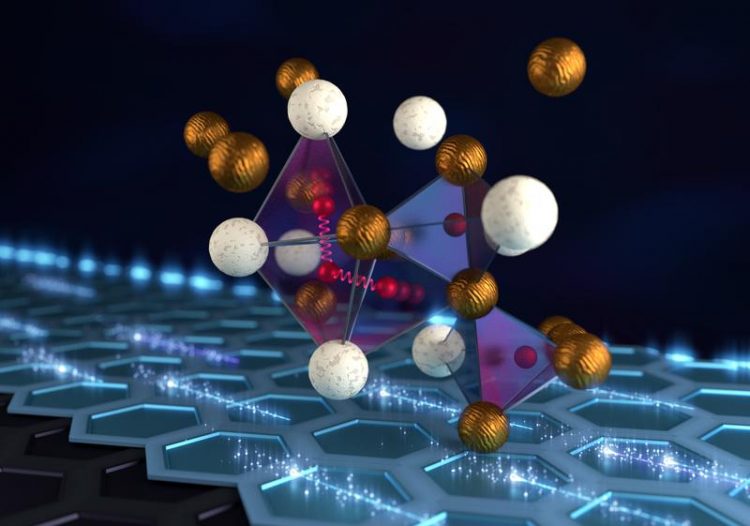New insights could lead to superconductivity in ambient conditions

Illustration of a zirconium vanadium hydride atomic structure: The lattice is composed of vanadium atoms (in blue) and zirconium atoms (in green) enclosing hydrogen atoms (in red). Jill Hemman / Oak Ridge National Laboratory, US Dept of Energy
The scientists conducted neutron scattering experiments at the Oak Ridge National Laboratory (ORNL) in the US on samples of zirconium vanadium hydride at atmospheric pressure and at temperatures as high as -23 degrees Celsius.
Their findings detail the first observations of such small hydrogen-hydrogen atomic distances in a metal hydride, as small as 1.6 angstroms (less than one millionth of a millimeter), compared to the 2.1 angstrom distances predicted for these metals, as the scientists report in the latest issue of the «Proceedings of the National Academy of Sciences» (PNAS).
This interatomic arrangement is remarkably promising since the hydrogen contained in metals affects their electronic properties. Other materials with similar hydrogen arrangements have been found to start superconducting, but only at very high pressures.
The research team included scientists from Empa, the University of Zurich, the Polish Academy of Sciences, the University of Illinois at Chicago, and ORNL.
“Some of the most promising ‘high-temperature’ superconductors, such as lanthanum decahydride, can start superconducting at about -20 degrees Celsius, but unfortunately require pressures as high as 1.6 million times atmospheric pressure to be formed,” says Rus Hemley from University of Illinois at Chicago.
”For decades, the ‘holy grail’ for scientists has been to find a material that superconducts at ambient temperature and pressure, which would allow engineers to design it into conventional electrical systems and devices.”
Simulations made by supercomputers
High-resolution inelastic neutron spectroscopy was used to probe the hydrogen interactions in the metal hydride. However, the resulting spectral signal, including a prominent peak at around 50 millielectronvolts, did not agree with what the models predicted.
The breakthrough in the understanding occurred after the team used ORNL's supercomputers. These computer simulations, along with additional experiments ruling out alternative explanations, proved conclusively that the unexpected spectral intensity occurs only when distances between hydrogen atoms are closer than 2.0 angstroms – which had never been observed before in a metal hydride at ambient pressure and temperature.
The team’s findings represent the first known exception to the Switendick criterion in a bimetallic alloy, a rule that holds for stable hydrides at ambient temperature and pressure the hydrogen-hydrogen distance is never less than 2.1 angstroms.
“An important question is whether or not the observed effect is limited specifically to zirconium vanadium hydride,” says Andreas Borgschulte from Empa's Advanced Analytical Technologies lab. “If we do theoretical calculations of the material respecting the Switendick limit, we cannot verify the peak. This leads to the conclusion, that in vanadium hydride, hydrogen-hydrogen pairs with distances below 2.1 angstroms definitely do occur.”
In future experiments, the researchers plan to add more hydrogen to zirconium vanadium hydride at various pressures to evaluate how much hydrogen the alloy can store in its lattice. The research was supported by the US Department of Energy, the Swiss National Science Foundation (SNSF) and the National Center for Research and Development in Warsaw.
PD Dr. Andreas Borgschulte
Advanced Analytical Technologies
Phone +41 58 765 46 39
andreas.borgschulte@empa.ch
A Borgschulte, J Terreni, E Billeter, L Daemen, Y Cheng, A Pandey, Z Łodziana, RJ Hemley, AJ Ramirez-Cuesta; Inelastic neutron scattering evidence for anomalous H-H distances in metal hydrides; PNAS (2019); doi: xxxxx xxxxxx https://www.pnas.org/content/early/recent
Media Contact
More Information:
http://www.empa.chAll latest news from the category: Materials Sciences
Materials management deals with the research, development, manufacturing and processing of raw and industrial materials. Key aspects here are biological and medical issues, which play an increasingly important role in this field.
innovations-report offers in-depth articles related to the development and application of materials and the structure and properties of new materials.
Newest articles

NASA: Mystery of life’s handedness deepens
The mystery of why life uses molecules with specific orientations has deepened with a NASA-funded discovery that RNA — a key molecule thought to have potentially held the instructions for…

What are the effects of historic lithium mining on water quality?
Study reveals low levels of common contaminants but high levels of other elements in waters associated with an abandoned lithium mine. Lithium ore and mining waste from a historic lithium…

Quantum-inspired design boosts efficiency of heat-to-electricity conversion
Rice engineers take unconventional route to improving thermophotovoltaic systems. Researchers at Rice University have found a new way to improve a key element of thermophotovoltaic (TPV) systems, which convert heat…



